| Home > Policy > White Paper, Notice, Announcement > White Paper > Japanese Government Policies in Education, Science, Sports and Culture 2000 > Part 1 Chapter 1 Section 1 1 | ||
As a result of the rapid economic recovery during the post-war period, Japan's per-capita income reached that of the United States for the first time in the mid-1970s. According to opinion polls conducted by the Prime Minister's Office, since this time a large number of people have begun to place more importance on spiritual wealth than material wealth.
Although Japanese economic growth has increased by 2-5% since the latter half of the 1970s, the economy stagnated after the prosperity of the so-called "bubble economy." Following a gradual recovery, it was again paralyzed at the same time as the Asian economic and currency crisis; it is now finally showing signs of recovery (See Figure 1-1-1 ).
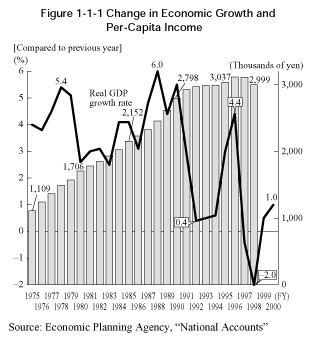
The recent economic downturn has created an environment in which it is very difficult for private corporations to provide support for cultural activities, as evidenced by the fact that several companies have been forced to close art museums which they have established, for example. Also, due to the drop in interest rates, the working profits of the Japan Arts Fund of the Japan Arts Council as well as the Arts Promotion Group (a foundation endowed with contributions from private corporations that promotes various cultural activities) are running low; consequently, as indicated by the reduction in the amount spent on the promotion of cultural activities, the environment surrounding cultural activities has become severe.
However, because, according to opinion polls conducted by the Prime Minister's Office, even in such an economic climate, the fact that the majority of people value material wealth over spiritual wealth has remained unchanged, a large number of citizens will demand spiritual fulfillment over material wealth (See Figure 1-1-2 and 1-1-3 ).
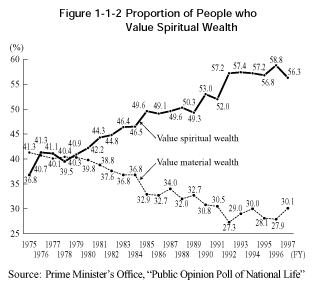
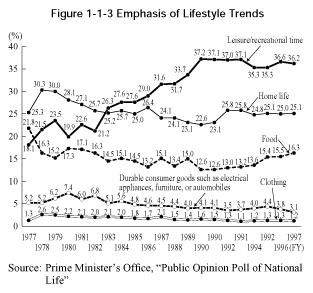
Japan's total fertility rate * was 1.34 in 1999, significantly less than 2.08, which is the level necessary in order to maintain the population (see Figure 1-1-4 ). The increase in the number of working women, the improvement in women's economic power, and the increasing tendency to marry later due to a change in consciousness of young people who prefer the freedom of single life have been pointed out as factors in the declining birth rate.
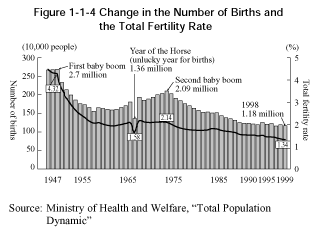
In terms of future projections, according to estimates from the National Institute of Population and Social Security Research, it is anticipated that, even if the birth rate recovers to a certain extent, the population will begin to decline from its peak in 2007, falling to 100 million by 2050 and 67 million (approximately one-half of the present population) by 2100.
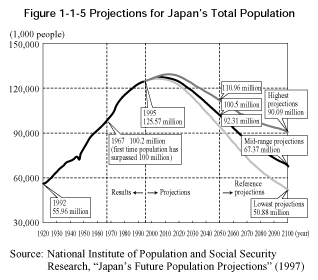
The Japanese population has recently begun to age very rapidly; the percentage of the population that is aged will increase from 16.7% in 1999 to 32.3% in 2050, at which point one in three citizens will be over the age of 65. Consequently, it will be necessary to heighten elderly people's consciousness of having a fulfilling life and improve opportunities for them to actively participate in various regional activities such as volunteer work. In particular, it will be necessary to devise a variety of activities in which men can participate as a member of local society, such as hobbies, culture and sports, to ensure that they are able to make a smooth transition from a working lifestyle to a retired lifestyle.
Although the gradual aging of the population and the declining birth rate would make it easier for funds to be invested in educational cultural activities for children, the reduction in the labor force and the shrinking of the market have engendered concerns that it may seriously affect the people of the future, such as a negative effect on economic growth or a drop in the vitality of local society.
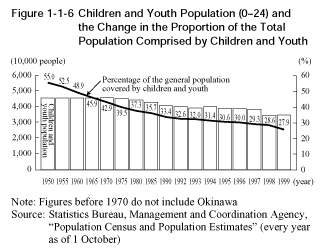
On the other hand, as analyzed in the "Annual Report on Health and Welfare" for 1999, after 2010, the "baby boom" generation (those born between 1947 and 1949), which supported not only the post-war economic growth but also Japanese society and culture, will begin to join the generation of the elderly aged 65 and over. This generation is clearly very different from the present elderly generation born during the Meiji (1868-1912) and Taisho (1912-1926) periods, in terms of work experience, lifestyle, life experience, culture and values, and consumption behavior (See Table 1-1-1 ).
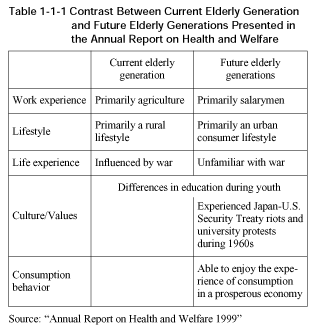
As analyzed by the FY1998 "White Paper on National Life," the "baby boom generation" popularized such Western fashions as jeans, miniskirts, and the Ivy League style, and formed the "new family"-the nuclear family unit living in a suburban residential apartment. Also, the spread of property rental and loans, the rise of culture centers (primarily for housewives), instant food products, and the increase in demand towards the restaurant industry have spread throughout the baby boom generation, soon to become a fixed social phenomenon or trend. In this way, the growth of the baby boom generation has given rise to a large number of fashion products, culture, and social phenomena, and new trends and cultures will continue to appear in accordance with the needs of this generation.
| *Total fertility rate |
The sum of age-specific fertility rates of women aged 15 to 49 which calculates the number of children one woman would bear if she gave birth at the annual age-specific fertility rate throughout her life.
The trend towards a five-day week can be seen in a survey by the Ministry of Labour-in 1998, 59.2% of workers worked a comprehensive five-day week (compared to 39.2% in 1990), and 95.6% worked at places that were introducing some form of five-day work week, such as alternating weeks (See Table 1-1-2 ). The total number of actual hours and the number of scheduled hours worked per worker (a total of all the industries surveyed comprising 30 or more employees) have followed a decreasing trend since 1988; in 1999 the figures were 1,842 hours and 1,709 hours, respectively (See Figure 1-1-7 ). Consequently, with the maturation of Japanese society, as exemplified by the increase in leisure time and the aging of the population, the desire for spiritual wealth and a meaningful life is being manifested in the growing demand for lifelong learning. Also, along with globalization, development of the information society, and the change in industrial structures, members of society are being compelled to constantly acquire new knowledge and skills, also creating demand for lifelong learning.
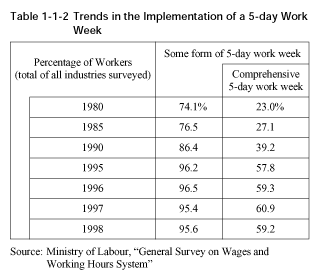
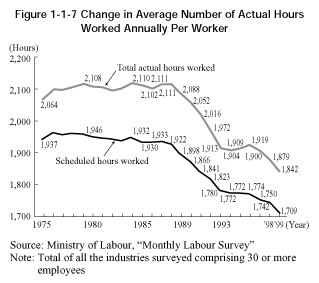
Lifelong learning is comprised not only of systematic, organized learning activities in the context of school education and social education, but also individual sports activities, cultural activities, hobbies, recreation, and volunteer work. Furthermore, these activities take place not only in schools but extend throughout community centers, libraries, museums, cultural facilities, sports facilities, culture centers, and companies and offices. Citizens' cultural activities play a significant role in lifelong learning.
According to the "Public Opinion Survey on Lifelong Learning" (1999) conducted by the Prime Minister's Office, "hobbies (music, art, flower arrangement, dance, calligraphy, etc.)" accounted for 22% of lifelong learning activities conducted in the previous year (See Figure 1-1-8 ) and 56.7% percent of respondents answered that they would like to participate in a hobby of some sort (See Figure 1-1-9 ).
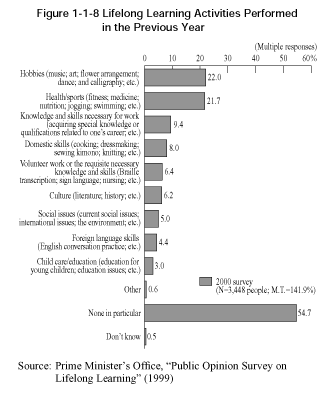
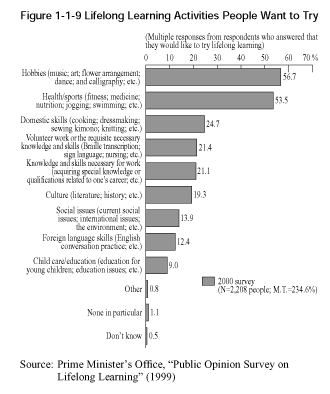
Additionally, 52.4% responded that lifelong learning had "enriched their lives" (See Figure 1-1-10 ).
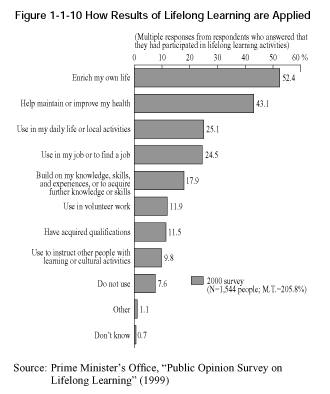
Many people have voiced the need to construct a lifelong learning society in which they can "freely choose opportunities to learn throughout their lives, the results of which will be evaluated appropriately" in order to realize a spiritually rich society in which the majority of citizens can participate in cultural activities. There is also the view that we must promote culture in order to expand opportunities to become familiar with our cultural assets and deepen the understanding of traditional culture.
(4) Rethinking and Rediscovering Traditional Culture
According to the "Survey on National Interest in Culture"(2000) conducted by the Agency for Cultural Affairs, approximately two-thirds of people have an interest in regional traditional culture: 69.7% of people have an interest in cultural assets such as ancient tombs, old shrines and temples, and historical streets; and 62.4% are interested in traditional folk performing arts (such as Shinto dances) and regional festivals (See Figure 1-1-11 , 1-1-12 ).
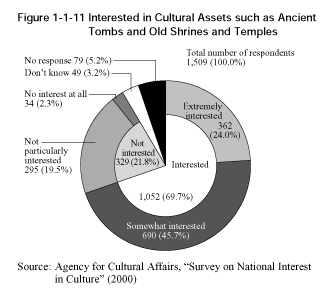
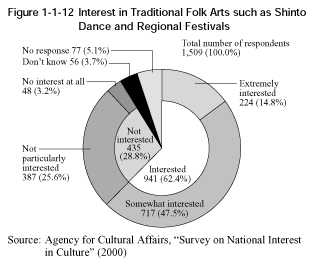
There are many examples of local economic development projects that have achieved results by focusing traditional culture such as arts, manners, and customs that have been preserved and inherited throughout the region, as well as historic sites, scenic views, and natural monuments and historic buildings and townscapes. According to the Agency for Cultural Affairs' survey (2000) concerning cities and towns in hilly or mountainous areas which fall within the scope of the applied so-called Five Laws Related to Depopulation such as the Mountain Development Law and the Peninsula Development Law, 68.0% of cities and towns are using or plan to use traditional culture in regional development projects (See Figure 1-1-13 ). The most popular form of traditional culture being used is "festivals, traditional events, and folk arts" followed by "historic buildings and townscapes" and "historic sites, scenic views, and natural monuments" (See Figure 1-1-14 ). "Promoting local culture," "promoting tourism," and "promoting hands-on learning and lifelong learning" were cited as objectives in using traditional culture (See Figure 1-1-15 ).
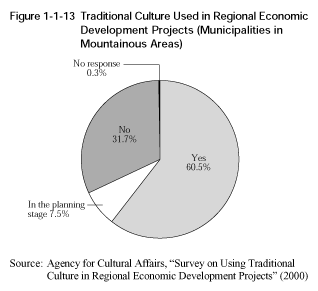
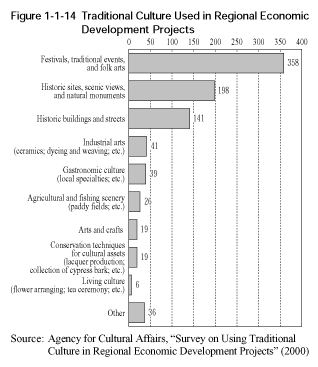
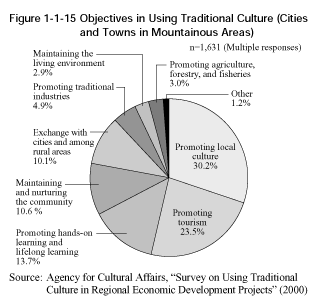
Regarding buildings in particular, it is expected that, through a system established in 1975 to designate important preservation districts for groups of historic buildings and a system for the registration of cultural properties introduced in 1996, historic streets and buildings will be used to promote activity in the region.
With regard to buried cultural properties, a great deal of historical knowledge has been accumulated over the past ten or so years based on successive discoveries such as the Yoshinogari site (Saga Prefecture), the Sannai-Maruyama site (Aomori Prefecture), and the Asukaike site (Nara Prefecture), attracting the attention of many citizens and stirring them to take an interest in ancient times.
Since Japan ratified the Convention Concerning the Protection of the World Cultural and Natural Heritage (the World Heritage Convention) in 1992, eight cultural heritages and two natural heritages in Japan have been inscribed on the World Heritage List. The inscription of the Japanese heritages has been a good opportunity for the Japanese people to recognize their own history and culture and to understand more about the preservation of cultural properties.
Also in 1992, the Law Concerning the Promotion of Sightseeing and Commerce and Industry in Designated Areas by Organizing Events Taking the Advantages of Traditional Music, Arts, and Other Local Cultures (the "Festival Law") was established to provide support for events that use local traditional performing arts, etc., for the purpose of promoting tourism, commerce, and industry. Also, the New Basic Law on Food, Agriculture, and Rural Areas (the New Agricultural Basic Law) was passed in 1999, which discovers new value in Japan's traditional culture and strengthens the movement to carry on that culture by placing "the succession of culture" as a part of the multifunctionality of agriculture and rural areas.
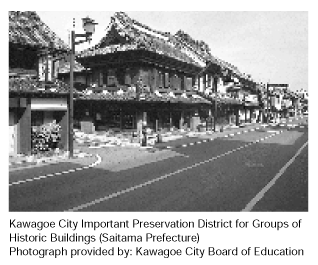
| Back to Top | MEXT HOME |